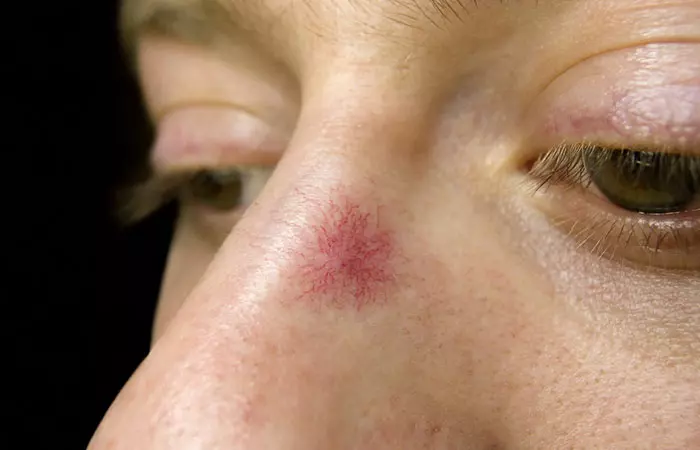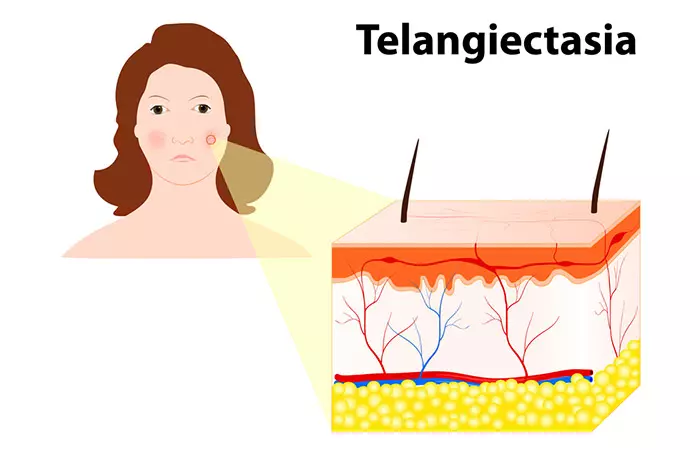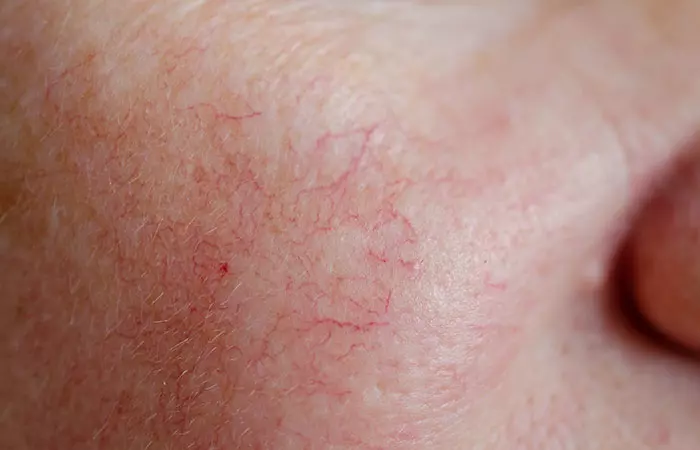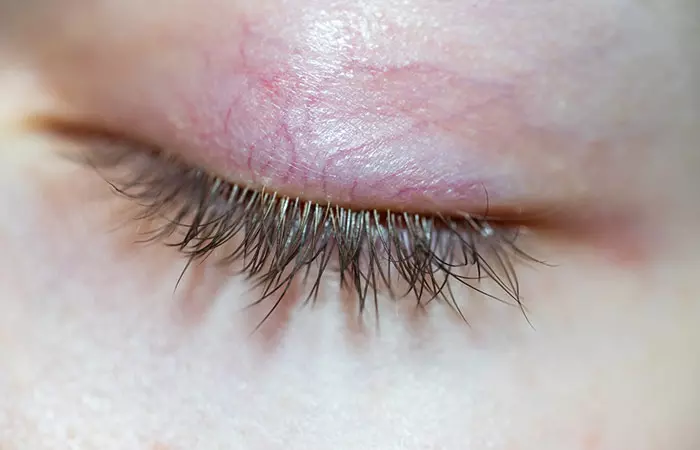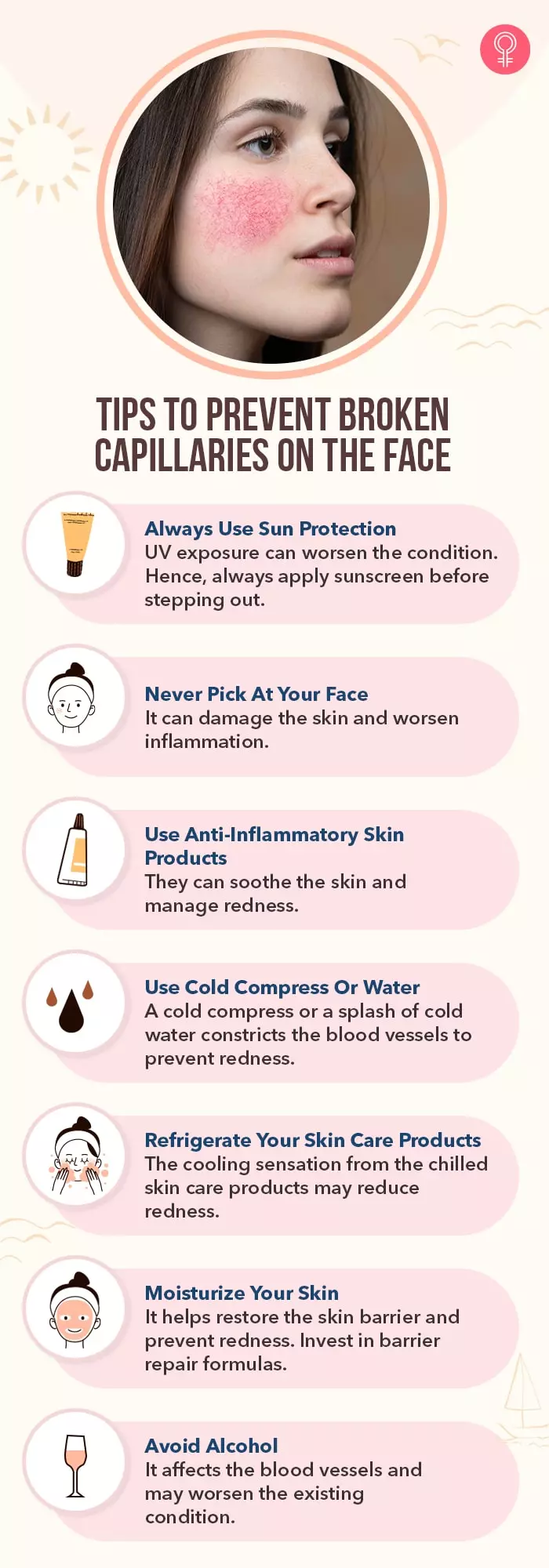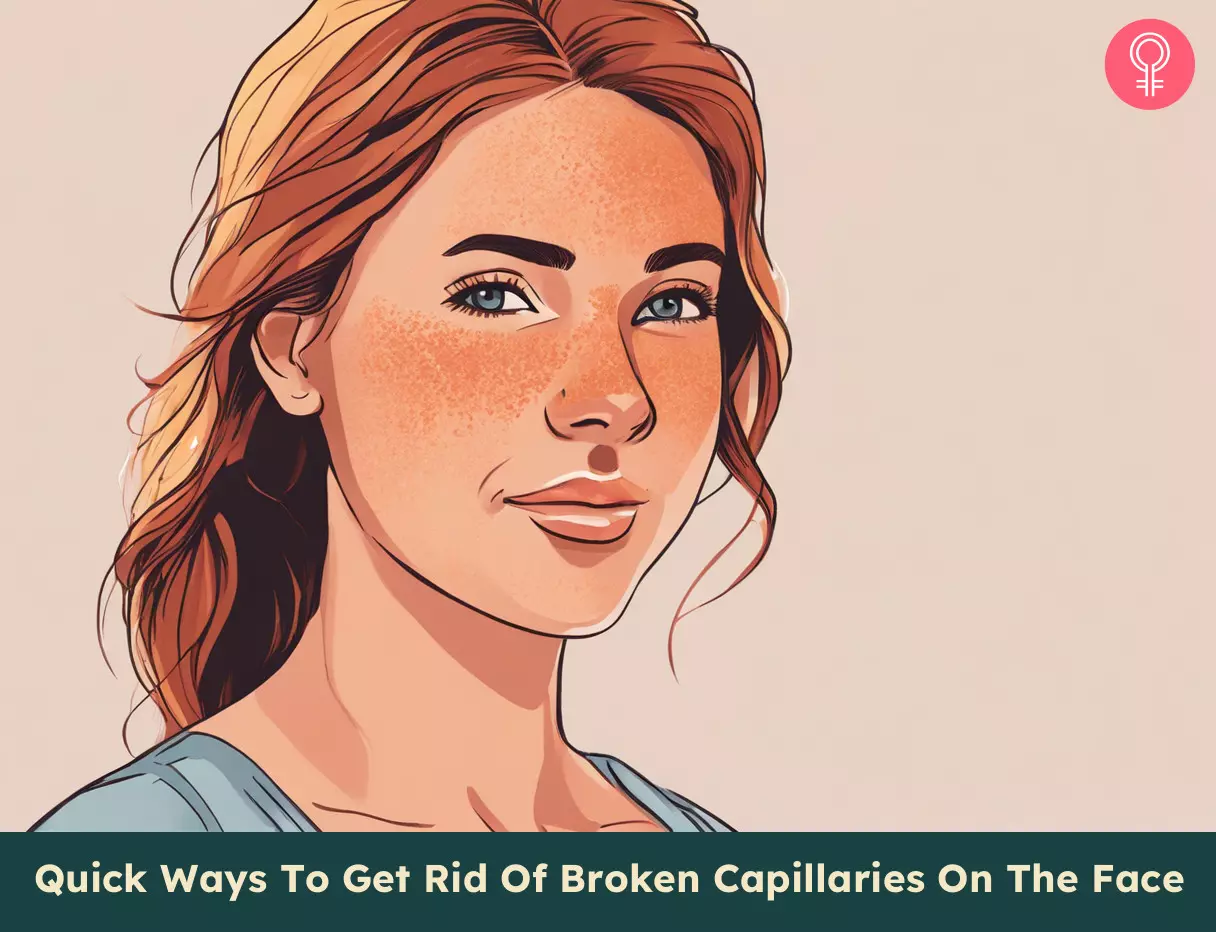While the exact reason behind this condition is not clear, it is a relief that broken capillaries are treatable. In this article, we discuss the symptoms, diagnosis, and treatment of broken capillaries on the face. Continue reading to know more about them.
What Are Broken Capillaries?
This condition is also known as telangiectasia or spider veins. In this condition, the blood vessels right beneath your skin surface enlarge or widen, creating red, web-like threaded patterns on your skin. They mostly appear in the areas around your lips, eyes, cheeks, nose, fingers, and legs. These usually appear in clusters. In most cases, broken capillaries on the face don’t affect your health. These are harmless unless caused by underlying health issues (we have discussed this later in the article). However, these patterns on your face can make you conscious about your appearance. Let’s find out the reasons behind this condition.
What Causes Broken Capillaries Or Blood Vessels On Your Face?
The exact cause of broken capillaries or telangiectasia is unclear. However, several factors may cause broken capillaries. They include:
Aging (blood vessels are weakened with age) Skin trauma (inflammation or bruises may cause broken capillaries) Genetic factors Excessive exposure to the sun and wind (damages the blood vessels and bring them close to the surface) Side effects of medicines (may enlarge the venules) Side effects of topical or oral corticosteroidsi A class of anti-inflammatory medicines used to provide relief from rashes, asthma, inflammatory bowel disease, and other conditions. (result in skin thinning and broken capillaries) Pregnancy (increased pressure on venules) Surgery Acne Excessive alcohol consumption (affects blood flow and causes liver issues)
During pregnancy, your chances of getting broken capillaries increase. The growing fetus puts excessive pressure on the blood vessels, breaking them. Hormonal therapy or taking birth control pills may also cause broken capillaries on the face. You may also inherit the condition. It is called Hereditary Hemorrhagic Telangiectasia (HHT). Five genes are suspected to cause this issue, and only three out of five could be identified. Only 1% of people inherit this condition. Apart from these causes, telangiectasia or broken capillaries can be a symptom of underlying health conditions. These include:
Bloom Syndrome (a rare genetic condition. Broken capillaries are one of its symptoms.) Liver disease Nevus Flammeus or Port-Wine Stain (large patch of skin discoloration caused by capillary malformation) Ataxia Telangiectasia (a rare inherited condition of body systems) Osler-Weber-Rendu Syndrome or Hereditary Hemorrhagic Telangiectasia Klippel-Trenaunay-Weber Syndrome (a condition combining Port-Wine Syndrome and varicose veins) Rosacea (a chronic skin condition) Xeroderma Pigmentosum (a rare condition that increases UV sensitivity of the skin and eyes) Spider Angioma (the blood vessels get collected closer to the skin surface) Sturge-Weber syndrome (a disorder affecting the nervous system)
Conditions that affect your connective tissues may also cause broken capillaries. They include lupusi A chronic, autoimmune medical disorder that leads to a hyperactive immune system that attacks healthy tissues and organs. , dermatomyositisi A rare long-term inflammatory medical condition marked by muscle weakness and a distinctive violet or dusky red skin rash. , and sclerodermai A rare chronic autoimmune disease that involves hardening and tightening of the skin and other body tissues. . According to the American Academy of Dermatology (AAD), it is estimated that 16 million Americans are affected by rosacea and 50 million Americans are affected by acne every year. It was further estimated that 85% between 12 to 24 experienced mild acne and 15% of adult women experienced acne.
Broken Capillaries: Symptoms And Diagnosis
Broken capillaries are easily visible on your skin. The symptoms include:
Fine, thread-like lines A web-like network of red lines Can be reddish, purple or bluish May cause itching and pain Measures between 1-3 mm Commonly found on chin, nose, cheeks
The red thread-like patterns on your skin surface make this condition easy to diagnose. In some cases, symptoms may also include swelling or redness around the affected area. This can indicate underlying issues such as rosacea or other vascular conditions. Doctors may also conduct clinical tests to determine if any underlying health condition caused broken capillaries. They might conduct the following tests:
CT scan MRI X-rays Liver function tests Blood tests
They may also conduct other related tests to detect any abnormalities. Depending on the diagnosis, they will treat your condition.
How To Treat Broken Capillaries On The Face? Do Home Remedies Work?
Telangiectasia cannot be cured. However, you can treat it. The treatment mostly depends on the diagnosis. If rosacea is causing broken capillaries, the doctor will try to treat rosacea to minimize the appearance of broken capillaries. Not all treatments work for everyone with broken capillaries. Hence, it is better to consult a doctor to find out which treatment method is suitable for you. Here are the treatment options for broken capillaries:
1. Topical Retinoids
Retinoids are used to treat many skin issues and can reduce the visibility of the capillaries. However, be careful as retinoids might cause redness and itching.
2. Laser Therapy
Doctors use lasers to destroy the damaged capillaries. This might involve a little bit of pain and discomfort and may also cause skin damage initially. However, your skin recovers quickly.
3. Sclerotherapy
In this process, the doctor injects sclerosing agents to seal the visible vessels and make them disappear. While this process can be painful for a few, not everyone experiences discomfort and pain. The recovery period is short.
4. Intense Pulsed Light (IPL)
This therapy is similar to laser therapy. However, the lasers used in IPL penetrate deep into your skin layers without causing any damage. In addition to these treatments, there are some commonly used home remedies to manage broken capillaries on the face.
5. Horse Chestnut
Horse chestnut has been used as an herbal remedy to treat chronic venous insufficiency, a condition characterized by poor blood flow, which causes swelling, pain, itching, and broken capillaries (2). Using products containing horse chestnut may help improve circulation and improve the appearance of broken capillaries on the face.
6. Arnica Oil
Arnica oil has been used as an herbal remedy in treating post-operative pain. It may also help with pain following varicose vein surgery (3). This may hint at the oil’s potential of treating broken capillaries.
7. Apple cider vinegar
Apple cider vinegar (ACV) has been traditionally used for various skin issues due to its anti-inflammatory properties. It helps improve circulation and can reduce the appearance of broken capillaries (4).
8. Green Tea
Green tea contains powerful antioxidants called catechins. It helps protect the skin from free radical damage. Its anti-inflammatory properties can help calm redness and promote the healing of broken capillaries (5).
9. Chamomile
Chamomile is another anti-inflammatory herb that can soothe skin irritation and reduce the appearance of broken capillaries (6). It helps to strengthen the blood vessels and calm redness, making it an excellent remedy for those with sensitive skin prone to capillary breakage.
10. Witch Hazel
Witch hazel is a natural astringent that helps tighten skin and reduce inflammation. It contains tannins that can shrink blood vessels and reduce the appearance of broken capillaries (7).
11. Rosehip Oil
Rosehip oil is rich in vitamins A and C, which help repair damaged skin and improve collagen production. It can aid in the regeneration of skin cells and reduce the visibility of broken capillaries over time (8).
12. Vitamin C
Vitamin C is known for its brightening and skin-strengthening properties. It helps to repair damaged blood vessels and supports collagen production, which can reduce the appearance of broken capillaries (9). Clare, a blogger, accidentally discovered that tea tree oil may help diminish spider veins. She writes, “My mom had spider veins, so I’m assuming I have them because she did. I started using tea tree oil because I was having a really bad break out that I wanted to control… I noticed after using it a week that my spider veins started to diminish. They haven’t gone all together by all means, but they certainly are much less noticeable than before (i).” It is important to note that research on these ingredients is limited. However, you may take care of your skin at home and follow these measures to prevent aggravating the condition any further:
Avoid Washing Your Face With Hot Water
Hot water can further damage your blood vessels. Even if you are using warm water, be gentle when using it on your face.
Use Cold Compress
Be it a bag of frozen peas or an ice pack, it can provide great relief. Right after sun exposure, apply a cold compress to prevent the appearance of broken capillaries.
Massage With Aloe Vera
Aloe vera has skin-soothing effects. Although it may not help with broken capillaries, it might help in soothing other skin issues, such as rosacea, and reducing redness (1). If your broken capillaries are a result of rosacea, aloe vera gel might help.
Minimize Sun Exposure
Avoid exposing your skin to the harmful UV rays during the peak hours. Always use good SPF (sun protection factor) sunscreen and cover yourself up properly if you are going out.
Control Your Alcohol Consumption
Drink in moderation. Consult a doctor and inquire if it is okay if you drink in moderation or you need to quit completely. Using these medicines and natural remedies can help reduce the appearance of broken capillaries on the face. However, if the condition persists, consulting a dermatologist for professional treatments might be necessary. If you are prone to broken capillaries, it will be best to take some preventive measures. Let’s check out some.
How To Prevent Broken Capillaries On The Face
Broken capillaries are often the result of weakened blood vessels, sun damage, or other factors like harsh weather or skin trauma. Here’s what you can do to prevent them from forming on your face.
1. Protect Your Skin From Sun Damage
Sun damage can weaken the blood vessels beneath the skin, making them more prone to breaking. To prevent this, always wear sunscreen with broad-spectrum SPF 30 or higher, even on cloudy days.
2. Be Gentle With Your Skin
Aggressive scrubbing, harsh exfoliation, or using hot water on your face can irritate and damage the delicate blood vessels. Be mindful of how you handle your skin, especially if it’s sensitive or prone to redness.
3. Limit Alcohol Consumption
Alcohol can cause blood vessels to dilate, leading to facial flushing and broken capillaries over time. Heavy or frequent drinking can weaken the blood vessels and make them more susceptible to breaking.
4. Manage Stress
Stress can cause blood pressure to rise, which in turn puts more pressure on your blood vessels. Chronic stress or emotional strain may contribute to broken capillaries as a result.
5. Avoid Overheating
Overheating from stress or physical activity can cause the vessels to dilate. Finding the time to exercise regular exercise and eat a balanced meal can help keep your blood vessels healthy.
6. Avoid Smoking
Smoking constricts the blood vessels, which can weaken them and make them more prone to breaking. Over time, smoking can lead to skin damage and increase the likelihood of broken capillaries. Quitting smoking not only benefits your overall health but also helps protect your skin from premature aging and capillary damage.
7. Use Skincare Products With Anti-Inflammatory Ingredients
Certain skincare ingredients have anti-inflammatory properties that can help strengthen blood vessels and prevent irritation. These ingredients can reduce redness, calm the skin, and support the overall health of your blood vessels. With these tips, you will be able to prevent broken capillaries and enjoy flawless skin. However, even after good care, some people seem to be vulnerable to broken capillaries. Here are some risk factors you need to keep in mind. Read on!
Risk Factors
The following reasons may increase your chances of developing broken capillaries on your face:
Pregnancy Exposure to the sun Alcohol abuse Aging Skin issues, such as rosacea, scleroderma, and dermatomyositis Corticosteroids
What are the long-term effects of broken capillaries? The long-term effects of broken capillaries are typically cosmetic. It can cause persistent redness or visible veins, but they generally don’t pose health risks. Can lifestyle changes help prevent broken capillaries? Yes, lifestyle changes like using sun protection, reducing alcohol intake, managing stress, and avoiding extreme temperatures can help prevent broken capillaries. Is it safe to use makeup over broken capillaries? Yes, it is generally safe to use makeup over broken capillaries, but opt for gentle, non-irritating products and avoid harsh rubbing during application and removal. Can broken capillaries heal on their own? Broken capillaries caused by injury or trauma can heal on their own, while broken capillaries caused by aging, loose skin, hormones, or medical issues may not heal completely. Does vitamin K cream help with broken capillaries? Anecdotal research suggests that applying vitamin K facial creams to bruises and broken capillaries can help them recover more quickly. Can makeup or skincare products cover up broken capillaries on the face? Yes, while makeup may not aid in reducing the appearance of broken capillaries, it can help cover them up. Try using a full-coverage foundation with a color-corrector to conceal them. Are there any foods or supplements that can help prevent or treat broken capillaries on the face? Yes, anecdotal evidence suggests the consumption of vitamin C supplements and eating vitamin K-rich foods like spinach and broccoli may aid in preventing broken capillaries.
Illustration: Quick Ways To Get Rid Of Broken Capillaries On The Face
Say goodbye to broken capillaries on your face! Click on this informative video to learn about effective techniques and tips for reducing and eliminating broken capillaries for flawless skin. Check out the illustration below to get tips on ways to use beauty and skin care products to prevent broken capillaries, which drinks to avoid, and various protective measures.Illustration: StyleCraze Design Team
